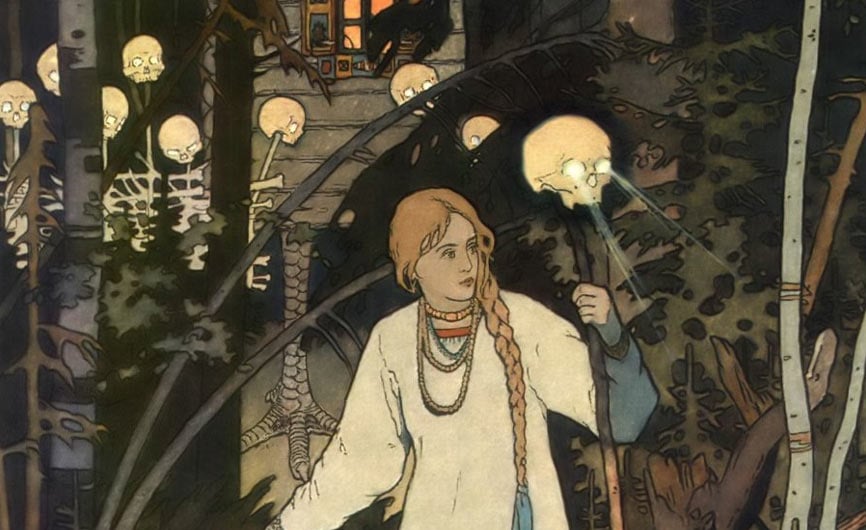A Freaky Fairy Tale of Ancient Folklore: Vasilisa the Beautiful and Baba Yaga
“[…] In the evening the girl laid the table and began waiting for Baba-Yaga. It grew dark. The black horseman swept by and it was night. The skulls’ eyes began to shine. The trees creaked, the dead leaves crunched, the earth trembled, and there was Baba-Yaga…”
-Vasilisa the Beautiful
Vasilisa the Beautiful is the name of a popular Russian fairy tale. In this story, the eponymous heroine is pitted against Baba Yaga, one of the best-known characters from Slavic folklore. The latter is an ambiguous supernatural being. In some fairy tales, Baba Yaga is portrayed as a benevolent being, though in others, she plays the role of the antagonist. Still, in other tales, it may be said that her character does not fit perfectly into either category of ‘good’ or ‘evil’.

Illustration by Ivan Bilibin of Baba Yaga, from the fairy tale ‘Vasilisa the Beautiful.’ (Public Domain)
One version of the tale of Vasilisa the Beautiful is in a collection of Russian folktales known as Народные Русские Сказки, which may be translated as Russian Fairy Tales or Russian Folk Tales. The stories in this collection were compiled during the 19th century by Alexander Nikolayevich Afanasyev, who has been considered the Russian equivalent of the Grimm Brothers. This is because in his lifetime, Afanasyev published almost 600 Russian folktales and fairy tales. Afanasyev’s first collection of tales was published in 1855 and consisted of 74 stories. Over the years, more tales were added, and the entire collection, which was completed in 1863, became known as Народные Русские Сказки.
- Who’s Afraid of the Big Bad Wolf? A Fearsome Beast in Legends and Tales Around the World
- What Pearls of Wisdom are Held in the Animal Tales of the Panchatantra?
- What did Cherry of Zennor See That Altered Her Reality and Shaped Ours? The Deeper Meanings of Faerie Folklore
The Tale of Vasilisa the Beautiful
The tale of Vasilisa the Beautiful begins by introducing the character of Vasilisa, whose mother dies when she was still young. Like the story of Cinderella, Vasilisa’s widowed father marries another woman, who has two daughters of her own. Vasilisa’s step-mother and step-sisters mistreat her by giving her lots of work to do. Fortunately, whilst on her deathbed, Vasilisa’s mother gives her daughter a magical doll, who helps the maiden to accomplish these tasks. One day, however, Vasilisa’s father had to go to a faraway place and was not expected to be back for some time. Vasilisa’s stepmother took this opportunity to send Vasilisa into the forest which their house was beside.

Illustration for the fairy tale ‘Vasilisa the Beautiful.’ (Public Domain)
The purpose of this was to obtain some light from the Baba Yaga, who lived in the forest, as their light had gone out. No doubt Vasilisa was terrified, as Baba Yaga is rumored to eat people. Nevertheless, with some encouragement from her magical doll, Vasilisa embarked on her journey into the forest. When she arrived at Baba Yaga’s hut, Vasilisa asked the old hag for some fire. In this story, Baba Yaga is not depicted as a benevolent character, and she said she would only give the fire to Vasilisa if she managed to complete several tasks.

In the fairy tale, Vasilisa must travel through the forest to reach Baba Yaga’s hut. (Public Domain)
Vasilisa’s Helpful Magic Doll
These tasks, however, were impossible for any normal human being to accomplish. One of these, for instance, was to sort a huge sack of millet seed by seed, and to remove all the black bits from it, all in one night. With the help of her magic doll, Vasilisa succeeded in this task.
- A Brothers Grimm Story Proven Right: Many Fairy Tales Stem from Ancient Oral Traditions
- Who Was Snow White? When Old Stories and Real Women Combine
- The ancient fairy tale of Cupid and Psyche, where love endures against all odds
In one version of the tale, Baba Yaga did not give Vasilisa the fire she promised but plotted to have her roasted. With the help of her doll once more, Vasilisa managed to escape from Baba Yaga. In the process, she also succeeded in getting the fire she was sent to obtain, which was contained in the skulls that decorated the fence surrounding Baba Yaga’s hut.

The fairy tale character Vasilisa has one of the skulls with light. By Ivan Bilibin. (Public Domain)
When Vasilisa brought the fire back to her house, it burned her step-mother and step-sisters to ashes. Having buried the skull outside her house, Vasilisa moved to the city, where she stayed in the home of an elderly woman. One day, Vasilisa weaved some cloth, gave it to the old woman, and told her to sell it.
Seeing how beautiful the cloth was, the woman decided not to sell it, but to bring it to the palace as a present for the Tsarevich. The tale ends on a happy note, as the Tsarevich married Vasilisa. The old woman and Vasilisa then move to the palace. When Vasilisa’s father returned from abroad, he too was invited to stay in the palace with his daughter. As for the magical doll, it was always kept in Vasilisa’s pocket.

The fairy tale ends happily, with the elderly woman and Vasilisa moving into the palace. (Public Domain)
Top image: An illustration of Vasilisa the Beautiful, by Ivan Bilibin. Source: Wikimedia.
By Ḏḥwty
References
Fairytalez.com, 2018. Alexander Afanasyev. [Online]
Available at: https://fairytalez.com/author/alexander-afansyev/
Jim H, 2016. Baba Yaga: The Wise Witch of Slavic Folklore. [Online]
Available at: https://www.historicmysteries.com/baba-yaga/
New World Encyclopedia, 2014. Baba Yaga. [Online]
Available at: http://www.newworldencyclopedia.org/entry/Baba_Yaga
www.oldrussia.net, 2018. Baba Yaga. [Online]
Available at: http://www.oldrussia.net/baba.html
Zheleznova, I. (trans.), 1966. Russian Fairy Tales. [Online]
Available at: http://www.arvindguptatoys.com/arvindgupta/65r.pdf

















